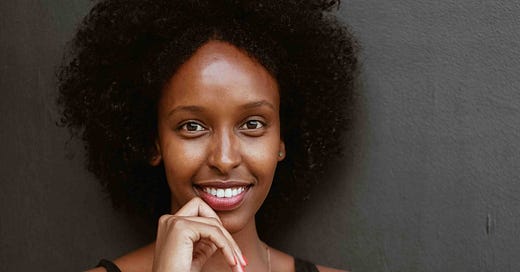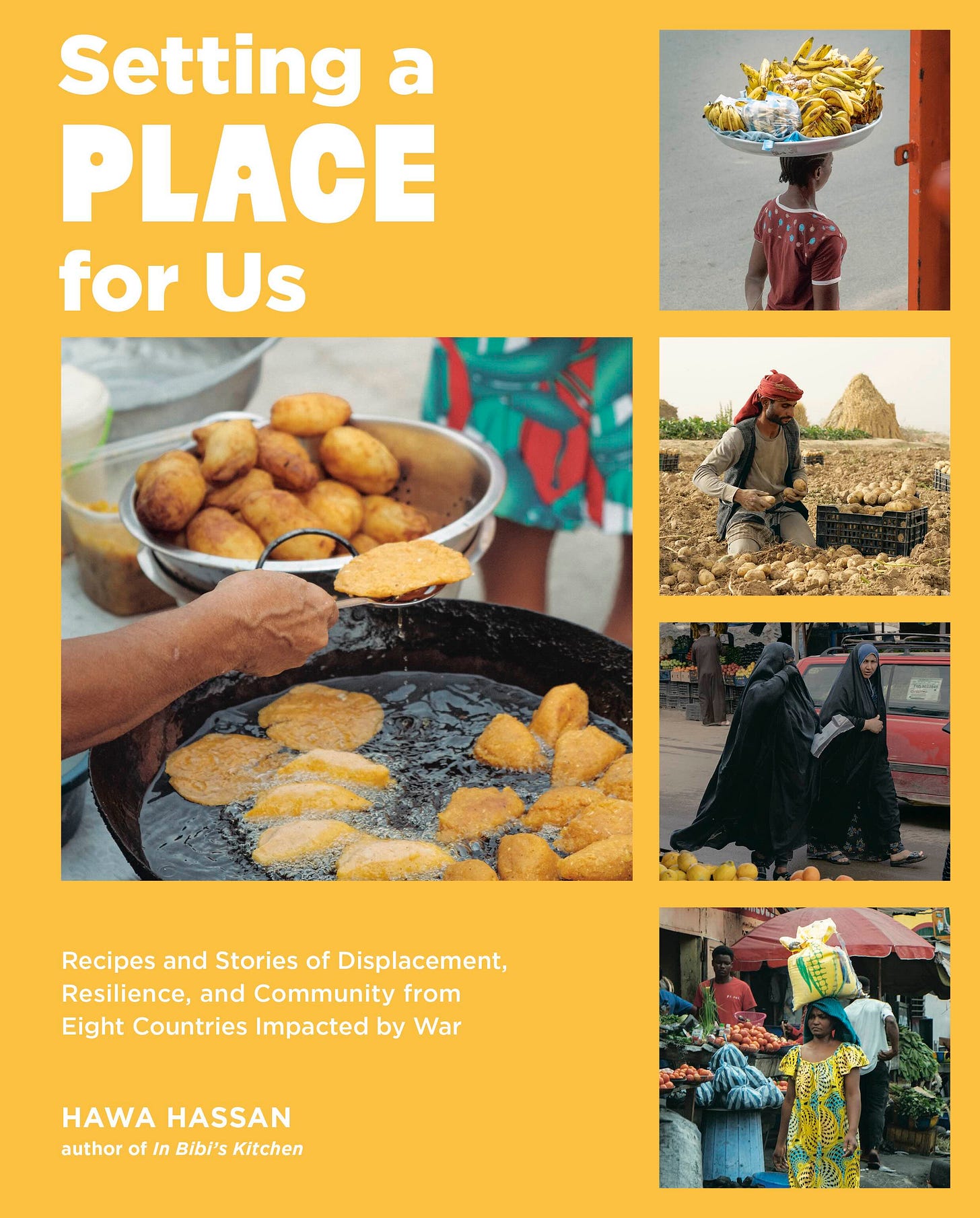There's So Much More to Food Than Going Viral, says Hawa Hassan
The author of Setting a Place for Us on why cookbooks matter and how she hopes people will come to her book for the recipes and stay for the history.
When I was answering the Cookbookery Q&A myself, I had an epiphany about the books I’m most drawn to. Many of them have an element of what I think of as “documentary-style” photos. I love a beautifully composed plate of food as much as the next gal, but seeing an image of people eating at a party that actually looks real (not styled within an inch of its life) or a shot of a street scene or a lush garden makes a book all the more immersive to me.
Hawa Hassan’s new book Setting a Place for Us (Bookshop/Amazon) may be the epitome of that type of cookbook. I haven’t literally counted, but I’m pretty sure the number of these documentary-style photos—of people, markets, landscapes—rival the number of recipe shots. It’s a remarkable book all around, and I’m so happy to hear more from Hawa about how it came together.
The subtitle sums it up perfectly: Recipes and Stories of Displacement, Resilience, and Community from Eight Countries Impacted by War. The countries featured are Afghanistan, Liberia, the Democratic Republic of Congo, El Salvador, Iraq, Egypt, Lebanon, and Yemen.
In the intro Hawa shares her personal story. She was born in Somalia, and at age 5, because of civil war, was forced to flee with her mother and siblings to a refugee camp in Kenya. Two years later, her mother sent Hawa to live with a family friend in Seattle, in search of the proverbial better life.
Hawa wasn’t reunited with her mother and siblings for 15 years. As a young adult she grappled with her personal history and had the spark of an idea. In the book’s introduction she recounts the moment:
I realize then that I can’t be the only one who’s been on that winding road of displacement. But why don’t I know others who’ve traveled similar paths? Where are our stories? This is the moment I know I will tell these big stories, and I will tell them through food, which is a perfect Trojan horse and a gateway into culture. Food is both a record of the upheaval of wartime and a comforting talisman of where you’ve come from and who you are. It’s the tie that binds you to your people wherever they are in the world.
With Setting a Place for Us, Hawa is asking for our attention and our empathy. But, the book isn’t just an exercise, a call to open your mind and heart. If you used the book solely for the recipes, it would be well worth the price of admission. I went to Hawa’s book launch party on Tuesday. All of the food was from the book, and it was uniformly delicious.
Hawa’s first book is the James Beard Award-winning In Bibi’s Kitchen: The Recipes and Stories of Grandmothers from the Eight African Countries that Touch the Indian Ocean (Bookshop/Amazon).
She is also the founder of Basbaas, a line of sauces and condiments inspired by her native Somalia. Thank you Hawa for answering these questions and for bringing this special book into the world!
The Cookbookery Q&A with Hawa Hassan
About how many cookbooks do you own?
HH: Too many to count! Like most folks who work in food, editors send me cookbooks each season, and I buy a fair amount to support friends and colleagues in the industry. My shelves are full, and I’m not mad about it.
How do you organize them?
HH: I don’t, honestly. When I’m in the thick of writing a cookbook, I try not to read any others. I want to stay focused and not confuse myself. But once I’m done writing and shift into the marketing phase, I finally get to dive into that stack of books from last fall or the season before. So I guess they’re organized by my desire to read them, whatever I’ve been dying to open gets read first.
Setting a Place for Us feels unique; it's like part cookbook, part documentary. How did it come to be?
HH: This book is rooted in the questions I’ve carried my whole life: What does it mean to start over? What gets left behind, and what do we carry with us? I’ve asked myself those things ever since I left my family as a child. I wanted answers, not just for me but for the larger community of people whose lives have been shaped by displacement. So I went searching, through food, through stories, through history. Setting a Place for Us was born from that place of curiosity, grief, and hope.
How did you decide on the book’s structure?
HH: I wanted the book to center people, their stories, their places and then the recipes. I always say: come for the food, stay for the history. My hope is that readers will walk away knowing more about these countries and the people who’ve shaped their cuisines.
What was the research process like, both for the recipes and the historical/cultural information?
HH: These countries—Afghanistan, the Democratic Republic of Congo, Egypt, El Salvador, Iraq, Lebanon, Liberia, and Yemen—are places that have faced deep instability, conflict, migration, and loss. But they’re also places of deep cultural pride, rich histories, and incredible food traditions.
The process involved a mix of on-the-ground reporting, interviews, and reading, a lot of reading. I wanted to understand how political histories, displacement, and everyday life shaped these foodways. And I made sure to speak to folks in-country and in the diaspora to ground the work in lived experience, not just research.
How did you source the recipes for this book?
HH: I worked closely with my longtime friend and collaborator Amy Stevenson. Together, we read books, combed through blogs, and most importantly, spoke directly with people from each country. We wanted each chapter to feel like an accurate reflection, not just of ingredients or techniques, but of the spirit behind each dish.
The location photography is captured by different photographers. Why was it important to you to have photos from the countries you feature, not just recipe photos?
HH: In all of my work, I want people to feel transported. That’s the joy of cookbooks; we get to tell stories visually, too. It was so important to show the countries themselves, the people, the street scenes, the markets. Recipes are only part of the story.
How was writing this book different than writing In Bibi’s Kitchen?
HH: In Bibi’s Kitchen was personal in a different way. It was about a continent I know intimately. Many of the countries in Setting a Place for Us were newer to me in terms of food and history, but the theme of displacement hit close to home. This book pushed me to sit with my own journey and reflect on what it means to rebuild from loss. It was both expansive and emotional.
What’s one thing you wish were different about the book?
HH: I honestly can’t think of anything. Every book teaches you something, and this one gave me more than I could’ve expected.
What are you most proud of when it comes to Setting a Place for Us?
HH: That it exists. That these stories and recipes are out in the world. I hope I did the people in it justice.
What are your hopes for the book?
HH: That it finds the people who need it. That it inspires someone to tell their story, or to cook a meal that reminds them of home.
What kind of cookbook reader/user are you?
HH: I read them like novels. I love the intros, the headnotes, the context. And then, when something really moves me, I cook from it.
What do you find boring in a cookbook?
HH: Right now, I find it a bit boring when someone with a huge social following gets a cookbook deal, but doesn’t have much to say. There’s so much more to food than just going viral. It’s culture, history, memory.
What’s a cookbook that changed the way you cook?
HH: Joe Yonan’s Mastering the Art of Plant-Based Cooking (Bookshop/Amazon). It really encouraged me to explore more plant-based options in my everyday meals.
What would you say to someone who questions why cookbooks still matter in our “digital age”?
HH: I’d say there’s nothing like holding a book in your hands. Paper invites presence.
Interview has been lightly edited. If you purchase a book through one of these links, I may receive a small commission.
More to Nibble On
Cover reveal for
’s latest, out in December. It’s an illo!The James Beard Foundation announced its cookbook award nominees. Congratulations Kristina Cho!
The Paradox of Restaurant Cookbooks (h/t
)NY Times Bestsellers: Just one, The Wishbone Kitchen Cookbook by Meredith Hayden with Rachel Holtzman (#2 on the list)
Thanks for reading!








![In Bibi's Kitchen: The Recipes and Stories of Grandmothers from the Eight African Countries that Touch the Indian Ocean [A Cookbook] See more In Bibi's Kitchen: The Recipes and Stories of Grandmothers from the Eight African Countries that Touch the Indian Ocean [A Cookbook] See more](https://substackcdn.com/image/fetch/$s_!T2V7!,w_1456,c_limit,f_auto,q_auto:good,fl_progressive:steep/https%3A%2F%2Fsubstack-post-media.s3.amazonaws.com%2Fpublic%2Fimages%2Fe2046ea4-fd2a-446e-a37e-7fffe329a9be_804x1000.jpeg)

Setting a Place for Us arrived yesterday and I already know it’s going to be sitting by my bedside for the foreseeable future so I can really dive in! Love Hawa and everything she does!
glad to see this covered...it's a very narrow window of the cooking community (and demographic) that drives viral recipes that the media loves so...beautiful, beguiling photos and the mantus call out!